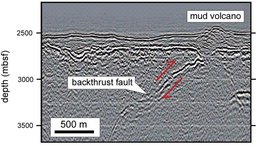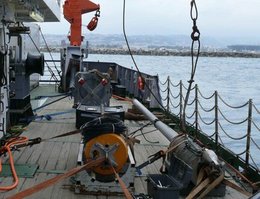Die Inhalte dieser Seite sind leider nicht auf Deutsch verfügbar.
Seitenpfad:
- Startseite
- Forschung
- Dynamik des Meeresbodens
- Completed projects
- former SD projects (2013 - 2017)
- CCP4 Key Hypotheses
CCP4 Key Hypotheses
Episodicity of mud extrusions is governed by tectonics and microbial processes, and in turn drives microbial activity and ecosystems.
The main objective of the proposed cross-cutting theme is to investigate the interactions of geological, physical, chemical, and biological processes at mud volcanoes by observing ongoing changes and reconstructing past evolution in order to improve estimates of gaseous and dissolved methane emission with time, and to better understand the role of mud volcanoes as geohazards. The investigations will be based on repeated mapping by AUV and side-scan sonar, insitu measurements of temperature and chemical parameters, and microbiological sampling along with long-term acoustic and video observations. From these data, we aim to identify changes in mud volcano activity and the morphology of mudflow generations, and to understand the associated succession of methanotrophs and chemosynthetic communities over time.
The main objective of the proposed cross-cutting theme is to investigate the interactions of geological, physical, chemical, and biological processes at mud volcanoes by observing ongoing changes and reconstructing past evolution in order to improve estimates of gaseous and dissolved methane emission with time, and to better understand the role of mud volcanoes as geohazards. The investigations will be based on repeated mapping by AUV and side-scan sonar, insitu measurements of temperature and chemical parameters, and microbiological sampling along with long-term acoustic and video observations. From these data, we aim to identify changes in mud volcano activity and the morphology of mudflow generations, and to understand the associated succession of methanotrophs and chemosynthetic communities over time.

Example of a mud volcano on the Mediterranean Ridge accretionary complex, including potential sources for fluids.
Transient changes in physical properties (low strength, high fluid content, low density) affect the mode of eruption, mud emplacement/flow, and long-term dynamics of a mud volcano.
Techniques such as dating of mud-flow events in cores using modeling of porewater chemistry, isotope geochemistry, or petrophysical proxies and assessing the fate of deep biosphere communities reaching the seafloor with ascending mud will be used. We will identify triggers of mud volcano eruptions by linking changes in pressure and temperature with geological transients (e.g. long-term incubation of sensors at a borehole observatory, MeBo-CORK, that will be funded through other sources), studying compression and flow behavior of gaseous sediments, and investigating the role of temperature and fluid flow in hydrate destabilization.
Techniques such as dating of mud-flow events in cores using modeling of porewater chemistry, isotope geochemistry, or petrophysical proxies and assessing the fate of deep biosphere communities reaching the seafloor with ascending mud will be used. We will identify triggers of mud volcano eruptions by linking changes in pressure and temperature with geological transients (e.g. long-term incubation of sensors at a borehole observatory, MeBo-CORK, that will be funded through other sources), studying compression and flow behavior of gaseous sediments, and investigating the role of temperature and fluid flow in hydrate destabilization.

CORK-A observatory completing a MeBo hole on a mud volcano in teh Kumano Basin, Japan. Here, pressure and temperature are monitored over time.


